المساعدات النقدية والقسائم والمخاطر
ما سبب أهمية هذا الموضوع؟
أحد الأسباب الرئيسية التي تجعل الجهات الفاعلة الإنسانية لا تفكر بشكل روتيني في النقد (الهدف رقم 2 من الإطار العالمي للعمل) هو تصورات المخاطر. ويرتبط هذا القلق بالتركيز المتزايد من قبل الجهات المانحة على مكافحة الإرهاب وغسيل الأموال وتقليص الميزانيات المخصصة للمساعدة الإنسانية.
كانت هذه نتيجة رئيسية من تقرير حالة العالم النقدي لشبكة CALP، والذي أشار أيضًا إلى أن الجهات المانحة قد تتسامح مع تحويل مبلغ صغير من المساعدات العينية ولكن يمكن أن تكون أكثر حساسية تجاه تحويل الأموال النقدية. تم نقل هذه الحساسية من الجهات المانحة إلى الوكالات الإنسانية الأخرى. تعتبر هذه القضية حساسة بشكل خاص في بيئات النزاع، حيث تشكل الجماعات المسلحة تهديدًا ويصعب على الجهات الفاعلة الإنسانية الوصول إلى المجتمعات المتضررة والإشراف على الاستجابة.
ما هو شكل التقدم المحرز في هذا المجال؟
لكي يتم النظر في المساعدات النقدية والقسائم بشكل منتظم، فإن النجاح يعني ما يلي:
- ويتم الكشف عن الخرافات بشأن المساعدات النقدية والقسائم ويتغير خطاب ومواقف وسلوك الجهات الفاعلة في المجال الإنساني حول مخاطر التحايل
- يتم النظر في المساعدات النقدية والقسائم بشكل منهجي وعلى قدم المساواة، على أساس أدلة المخاطر الفعلية عبر الطرائق
- لا تمنع الحواجز التنظيمية، مثل أجندة الجهات المانحة لمكافحة الإرهاب والتخلص من المخاطر، النظر المنتظم في النقد.
- يتم التعامل مع المخاطر من خلال التعاون بين الجهات الفاعلة الإنسانية التشغيلية والحكومات والجهات المانحة والمؤسسات المالية.
يمتلك الموظفون التشغيليون القدرات والأدوات العملية لتحديد المخاطر والتخفيف من حدتها.
للعمل نحو هذه الأهداف يعني معالجة المخاطر على مدار دورة المشروع، بناءً على الأسئلة التالية:
- تحليل الموقف: كيف يتم إدراك المخاطر الخاصة بالمساعدات النقدية والقسائم؟
- تحليل الاستجابة: كيف تؤثر مخاطر محددة من المساعدات النقدية والقسائم على اتخاذ القرار؟
- تصميم البرنامج: ما هي تدابير التخفيف المطبقة بالفعل؟
- التنفيذ: كيف يمكن أن اعتماد البرامج وتدابير التخفيف بمرور الوقت؟
- الرصد والتقييم: ما مدى فعالية تدابير التخفيف وما هو تأثيرها؟
المبادرات والأخبار الجارية
على مدار الأشهر المقبلة، سنعقد مجموعة من الاجتماعات مع الجهات الفاعلة لمناقشة مواضيع مختلفة تتعلق بموضوع المخاطر، مع أهداف تعزيز النقاش وتوليفه، وتوفير منتدى للجهات الفاعلة لمشاركة أفضل الممارسات، وضمان تعزيز الخبرات على المستوى الميداني في العالم.
17 تشرين الأول: الندوة: مشاركة البيانات الخاصة بالمساعدات النقدية والقسائم: الأخلاق والملكية والخصوصية
29 تشرين الأول: المساعدات النقية والقسائم والمخاطر المتعلقة بالاحتيال وحماية المستفيدين، دوالا، الكاميرون
31 أ تشرين الأول – 1 تشرين الأول: المساعدات النقدية والقسائم في سوريا، غازي عنتاب، تركيا (حدث خاص)
21 تشرين الثاني: الندوة: الجاهزية التنظيمي لإدارة البيانات.
26 تشرين الثاني: التركيز على حماية بيانات المستفيدين في العمل، داكار، السنغال.
4 كانون الاول: فعالية أسبوع النقد: مكافحة تمويل الإرهاب وتدابير مكافحة غسل الأموال في المساعدات النقدية والقسائم، ومسؤولية البيانات وحمايتها في المساعدات النقدية والقصائم في المجال الإنساني، لندن، المملكة المتحدة. تعرف على المزيد هنا.
تعمل مجموعة متنوعة من المنظمات حاليًا على المساعدات النقدية والقسائم والمخاطر. تعمل شبكة CALP على تحديد أوجه التآزر بين الجهات الفاعلة، وتجنب الازدواجية، وتحديد الأولويات المشتركة التي يمكن معالجتها بشكل جماعي بشكل أفضل. بالاشتراك مع برنامج الأغذية العالمي، تشارك شبكة CALP في تحديد أولوية المخاطر ضمن مسار عمل الصفقة الكبرى بشأن النقد.
دراسة حالة عن المخاطر في مالي باللغتين الإنجليزية والفرنسية.
دراسة حالة عن المساعدات النقدية والقسائم والمخاطر في اليمن، تقرير كامل.
يمكن مشاهدة ندوة الويب الخاصة بنا حول مشاركة البيانات في المساعدات النقدية والقسائم: الأخلاق والملكية والخصوصية
يمكن مشاهدة ندوة الويب الخاصة بنا التي تعرض رؤى من مؤلفي دراسات الحالة الخاصة بنا في اليمن وشمال مالي.
لمزيد من المعلومات، يرجى الاتصال بآنا كونداخشيان.
Latest
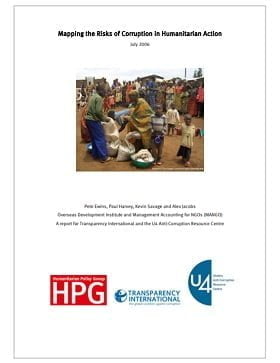
Mapping the Risks of Corruption in Humanitarian Action
Report
The issue of corruption in emergency relief and rehabilitation is a key concern for practitioners, who invest considerable resources and energy in trying to minimise it. However, it has barely been discussed in policy terms, and little researched. This paper aims to map the risks of corruption in the...

Voucher Distributions
Report
This document is largely based on the experience gained by GOAL’s team in its response to the 2005 earthquake in Pakistan and aims to discuss:
1. Options for transferring resource to a community in an emergency situation.
2. The appropriateness of the different methods of resource transfer to different
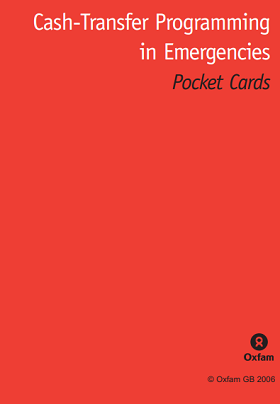
Cash-transfer programming in emergencies – Pocket cards
Report
In emergencies, distributing cash can often meet people’s immediate needs more quickly and appropriately than the direct distribution of commodities. Cash gives people choices and thereby preserves their dignity. These 15 cards contain key elements from the book, which draws on Oxfam’s experience to...
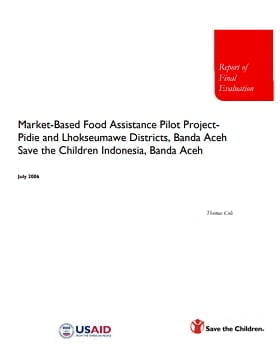
Market-Based Food Assistance Pilot Project Pidie and Lhokseumawe Districts, Banda Aceh: Report of Final Evaluation
Report
This report represents the findings of a final evaluation undertaken for Save the Children Indonesia/Banda Aceh of its Market-based Food Assistance (MBFA) Pilot Project carried out in Pidie and Lhokseumawe districts in early 2006. For 3 months, from February-April 2006, SC/BA implemented a pilot project,...
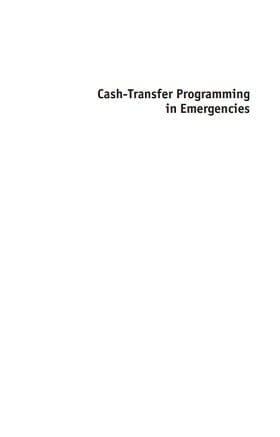
Cash-transfer programming in emergencies
Guidelines and Tools
A compact and concise guide aimed at supporting programme managers to assess whether cash is the most appropriate response in an emergency and choose between different types of cash-based interventions. This guide is based on the experience of Oxfam GB over five years (2000–2005) in a variety of...
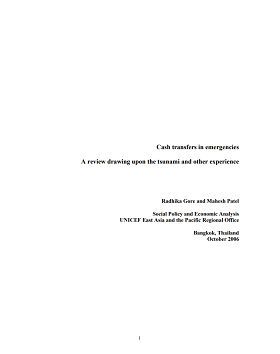
Cash Transfers in Emergencies: A Review Drawing upon the Tsunami and Other Experience
Report
This 2006 document from the Social Policy and Economic Analysis office of UNICEF (East Asia and the Pacific Region) draws upon examples from the tsunami and other contexts to explore cash transfer experience in emergencies. It presents existing evidence of impact of cash transfers on children; reasons...
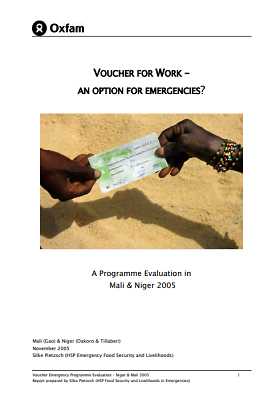
Voucher for work: An option for emergencies?
Report
This Oxfam GB evaluation report gathers successes, constraints and lessons learned during the implementation of two voucher programmes in Mali and Niger, following the food crisis in 2005. It begins by examining the appropriateness of the programme decision-making, and then looks at the two programme...

ODI/UNDP Cash Learning Project Workshop in Aceh, Indonesia
Case Study
This is a report from a workshop on sharing experiences and learning for cash-based interventions. The workshop was held in Aceh, Indonesia in July 2005. The workshop included case studies from Mercy Corps, Panglima Laot, Save the Children, British Red Cross, Swiss Development Corporation, Oxfam and...
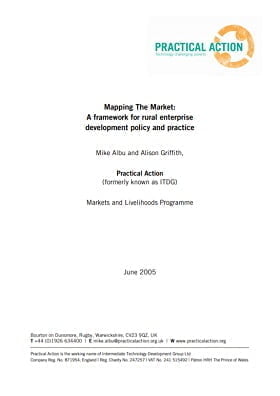
Mapping the Market: A framework for rural enterprise development policy and practice
Guidelines and Tools
Markets matter to the rural poor. It is increasingly clear that in tackling rural poverty, market-related issues – including access to information, institutions, linkages and trade rules – are vital considerations. Failure to address these issues means that the benefits of other developments...
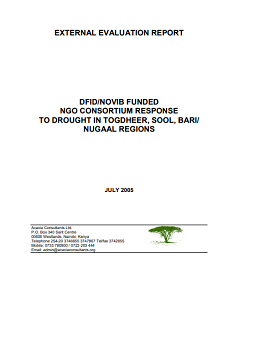
DFID/NOVIB Funded NGO Consortium Response to Drought in Togdheer, Sool, Bari/ Nugaal Regions
Case Study
This is a summary of the June 2005 evaluation of the NGO Consortium response to drought in Togdheeer, Sool, Sanaag and Bari/ Nugaal in Somaliland. The consortium response to drought was meant to provide cash to targeted drought-affected households to help them meet their basic needs. Important among the...

Evaluation of OFDA Cash for Relief Intervention in Ethiopia: Final Report
Report
As a result of insufficient rainfall in 2002 and 2003, the Ethiopian Disaster Prevention and Preparedness Commission (DPPC) issued an international appeal for food assistance in December 2003. Some 7.2 million people were estimated to be at risk in 2004. An OFDA/DART’s response to this crisis resulted...

Seed vouchers and fairs: A manual for seed-based agricultural recovery in Africa
Guidelines and Tools
This manual describes a new (2002) approach to post-emergency seed distribution in Africa, where farmers receive not free seed but vouchers that can be exchanged for seed at a specially organized seed fair. Seed fairs rely on commercial seed firms (where they are in operation), as well as local seed...

Clients First! A Rapid Market Appraisal Tool Kit: Theoretical background and experiences from various RMA events
Guidelines and Tools
Clients First! focuses on one vital element of market research that should be carried out before deciding to support at the agricultural production side or to proceed with an agribusiness project: a market feasibility study. The publication describes the main characteristics of a basic market study as...

Cash Transfers in Emergencies: Evaluating Benefits and Assessing Risks
Report
In terms of both theory and practice, there appears to be a strong case for cash-based responses to food emergencies where the supply and market conditions are appropriate. Amartya Sen’s work on entitlements offers a solid theoretical base for cash transfers, and the practical experience so far, limited...

Walking the Talk Presentation to the Zimbabwe CTWG May 2011
Presentation
Presentation accompanying the report ‘Walking the Talk – the Impacts of Cash Transfers on Gender Relations’ commissioned by Oxfam & Concern.
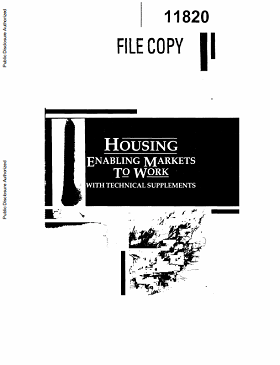
Housing: Enabling markets to work with technical supplements
Report
This policy paper discusses the evolving role of the World Bank in the housing sector and provides a new agenda for housing policy and institutional reform in developing countries. It explains the rationale for a new housing policy statement, presents a conceptual and analytical framework for...

ربط آليّة الاستجابة السريعة بتوفير المساعدات النقدية وحماية المرأة: دراسة حالة اليمن
تقرير
The rapid response mechanism (RRM) in Yemen aims to provide a minimum package of critical life-saving assistance for newly displaced persons. This is led by UNFPA in partnership with WFP and UNICEF. The RRM serves as an entry point for the provision of multi-purpose cash assistance and to address...


